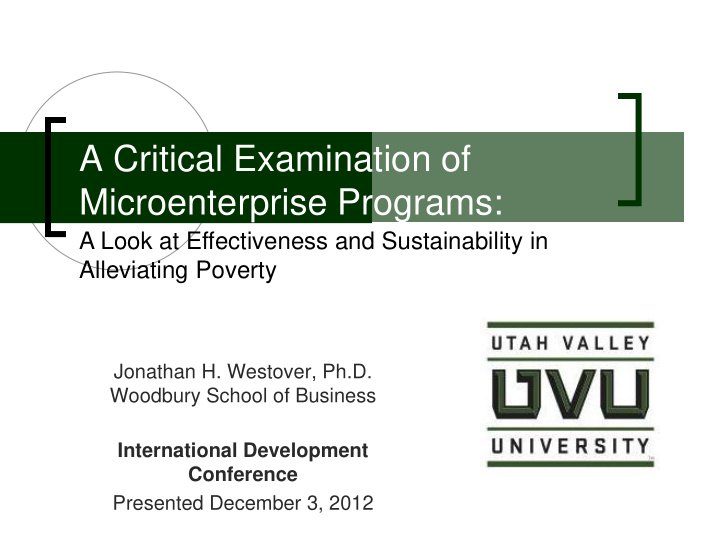



A Critical Examination of Microenterprise Programs: A Look at Effectiveness and Sustainability in Alleviating Poverty Jonathan H. Westover, Ph.D. Woodbury School of Business International Development Conference Presented December 3, 2012
Agenda Research Problem Research Questions Literature Review Method Review of Existing Studies and Findings Critique of the Existing Literature and Future Directions Conclusion Utah Valley University
World Poverty Utah Valley University Visualizing Poverty Over Time
Percentage Population Living on Less than 1 Dollar a Day 2007-2008 Utah Valley University
Access to Financing around the Globe Utah Valley University
Research Problem 1/6 of poor people throughout the world have access to formal financial services (World Bank) Estimated 7,000 microfinance institutions serving approximately 16 million poor individuals (World Bank) Utah Valley University
Regional Breakdown of Availability of Microfinance Services Source: www.unitus.com/wwd_whatismf.asp Utah Valley University
The Microfinance “Revolution”?? Growing popularity of microfinance in recent years New legitimacy?? Muhammad Yunus (founder of Grameen Bank) won Nobel Peace Prize in 2006 Utah Valley University
Research Questions 1. What is the record of microfinance programs? What is the effectiveness/ineffectiveness of such programs on reducing poverty? What are the predominant methodological approaches in the microfinance literature? Utah Valley University
Literature Review Method EBSCO Host Research Databases search “Microfinance and poverty” and “microcredit and poverty” Scholarly articles published between 1996-2011 Read abstracts and selected articles that seemed to best fit question/report on different aspects for full view Looked at some popular media sources Looked at MFI websites Utah Valley University
Background to Microfinance Microfinance started in Bangladesh around 1976 with Muhammad Yunas and Grameen Bank Financial services offered to low SES individuals that are excluded from the traditional financial system “Joint Liability Concept”: groups of individuals, usually women, group together to apply for loans, and hold joint accountability for repayment of the loan MF unique as a development tool because of potential to be self- sustaining Utah Valley University
Some Reported Positive Impacts of Microfinance Effective way to provide low-cost financial services to poor individuals and families (Miller and Martinez 2006; Stephens and Tazi 2006) Standard of living increases at the individual and household levels (Khandker 2005) Empowerment of women, through opportunities to take on leadership roles and responsibilities (Goetz and Gupta 1995) Utah Valley University
Microfinance Alleviating poverty?? MFI help to alleviate poverty (Khandker 2005); poverty in the sample villages declined 17% between the two waves of the survey, and extreme poverty declined 13% MFI do not help to alleviate poverty (Morris and Barnes 2005; Kan, Olds, and Kah 2005; Goetz and Gupta 1996) Mixed results (Copestake, Bhalotra, and Johnson 2001; Morduch 1998) Positive: Standard of living increases, which help to eradicate extreme poverty and hunger, have occurred at both the individual and household levels as a result of microfinance programs (Khandker 2005) Negative: Says that other studies are “overly optimistic” on MFI role in alleviate poverty (Kan, Olds, and Kah 2005, p. 146) Negative: Microfinance programs benefit the moderately poor more than the destitute?? (Copestake et al. 2001; Morduch 1998; Dugger 2004) Mixed: Reducing financial vulnerability, not reducing poverty? (Morris and Barnes 2005; Morduch 1998) Utah Valley University
Critique of the Existing Literature and Future Directions “While strong claims are made for the ability of microfinance to reduce poverty, only a handful of studies use sizable samples and appropriate treatment/control frameworks to answer the question” (Morduch 1998, p. 1) Study Design Problems Program feasibility studies and case-study approaches Cross-sectional Data Self-report Measures (including cultural bias) Non-Random Sampling Procedures (including convenience sampling) Generalizability Problems Replicability Problems Future Directions A need for more rigorous quantitative studies Do MFI cannibalize other programs? (see Neff 1996) Does microcredit hurt the poor? — microcredit dependency? (Copestake et al. 2001; Morduch 1998) Utah Valley University
Conclusion: Revisiting Initial Questions What is the record of microfinance programs? “Expectations are high, but evidence of the impact of microcredit remains in short supply” (Copestake, Bhalotra, and Johnson 2001) What is the effectiveness/ineffectiveness of such programs on reducing poverty? Mixed… some studies report positive effects on alleviating poverty, some report negative effects, and some report mixed effects MFI may be better equipped to reduce financial vulnerability and help moderately poor than to alleviate extreme poverty What are the predominant methodological approaches in the microfinance literature? Not rigorous enough; more rigorous quantitative studies needed Utah Valley University
Recommend
More recommend